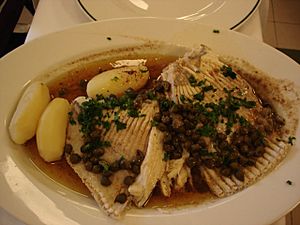Beurre noir facts for kids

A plate of skate with beurre noir
|
|
| Type | Sauce |
|---|---|
| Place of origin | French |
| Main ingredients | liquid butter |
Beurre noir (pronounced burr nwahr) is a classic French sauce that means "black butter." It's not actually black, but a very dark brown. This special sauce is made by cooking butter slowly until the tiny bits of milk inside it turn a deep, rich brown color.
Once the butter reaches this dark shade, a little bit of acid is carefully added. This is usually lemon juice or a type of vinegar. Sometimes, a sprig of parsley is cooked in the butter too, but it's taken out before the acid is added. Beurre noir is often served with dishes like eggs, fish, or different kinds of vegetables.
Contents
What is Beurre Noir?
Beurre noir is a simple yet flavorful sauce. It starts with regular butter. When butter is heated, the water in it evaporates. The milk solids, which are tiny protein and sugar particles, begin to cook. As they cook, they turn golden brown, then a nutty brown, and finally a very dark brown. This process is called Maillard reaction, which gives food a rich, toasted flavor.
How is Beurre Noir Made?
Making beurre noir is quite easy, but it needs careful attention.
Ingredients
You only need a few things to make this sauce:
- Butter: This is the main ingredient. Unsalted butter is often preferred.
- Acid: Usually lemon juice or vinegar (like red wine vinegar or sherry vinegar). The acid helps to stop the cooking process and adds a bright, tangy flavor.
- Optional additions: Sometimes, a sprig of fresh parsley is used.
Cooking Steps
Here's how it's generally made:
- Melt the butter: Place butter in a light-colored pan over low to medium heat. A light-colored pan helps you see the color change.
- Cook until dark brown: The butter will first melt, then foam. The milk solids will start to turn golden, then brown, and finally a very dark brown. It's important not to burn it, or it will taste bitter.
- Add acid: As soon as the butter reaches the desired dark brown color, remove it from the heat. Carefully add the lemon juice or vinegar. It will sizzle and foam up. This stops the cooking and adds a tangy contrast to the rich butter.
- Strain (optional): Some chefs strain the sauce to remove the dark milk solids, making it smoother. Others leave them in for extra texture and flavor.
Serving Beurre Noir
Beurre noir is a versatile sauce that pairs well with many dishes.
- Fish: It's a classic pairing with white fish like skate, cod, or sole. The rich, nutty flavor of the sauce complements the delicate taste of the fish.
- Eggs: It can be drizzled over omelettes, scrambled eggs, or poached eggs for a gourmet touch.
- Vegetables: Steamed or boiled vegetables like asparagus, green beans, or cauliflower taste wonderful with a spoonful of beurre noir.
- Pasta: Sometimes, it's used as a simple sauce for pasta dishes.
History of Beurre Noir
The use of browned butter in cooking has been around for a long time. French cuisine is famous for its sauces, and beurre noir is one of the foundational ones. It shows how simple ingredients can be transformed into something delicious with careful cooking techniques. This sauce highlights the rich flavors that can be created by browning butter, a technique used in many different cuisines around the world.
See also
 In Spanish: Beurre noir para niños
In Spanish: Beurre noir para niños

